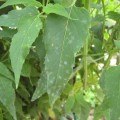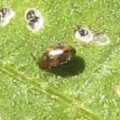Sudden wilting is caused by various reasons, Bacterial Wilt being one of them. Bacterial wilt is caused by different pathogens, depending on whether you are dealing with nightshades (pepper, tomato, potato, eggplant, tomatillos) or cucurbits (cucumber, melons, squash). In tobacco, it is known as Granville Wilt. Since there are various reasons for a plant to wilt, it is often difficult to diagnose what is causing the wilt.
Physical Description
Ralstonia solanacearum is an aerobic gram-negative bacterium. It is soil-borne and motile in the liquid phase of the soil. It does not form spores that resist drying or high heat. Recently it was classified as Pseudomonas, although it doesn’t fluoresce when grown in culture.
Species & Taxonomy
- Kingdom: Bacteria
- Phylum: Proteobacteria
- Class: Betaproteobacteria
- Order: Burkholderiales
- Family: Ralstoniaceae
- Genus Species: Ralstonia Solanacearum (only in nightshades)
Lifecycle
Plants Affected
Plants Unaffected
Geographical Range
Signs & Symptoms
Whole Plant
- sudden wilting
- death
Leaves
Flowers
Fruit
Roots/Tubers
How to Positively Identify
- confirm diagnosis by cutting into the main stem at the soil line; if a brown slime oozes from the stem, then you’ve got it (VGPS)
- slimy, sticky ooze forms tan-white to brownish beads where the vascular tissue is cut (stem)
- another way to confirm diagnosis is to cut the stem cross-wise, then hold the two cut ends together for a few seconds. When pulled slowly apart, thin thread(s) of ooze can be seen.
- one more way: suspend a cut stem in a clear container of clean water. If the bacteria is present, the bacterial ooze will form a whitish thread from the cut end down
Treatment
- The pathogen, Ralstonia Solanacearum, can survive for several years in the soil
- Enriching the soil with compost and not growing nightshades for several years will reduce future problems, but be sure to not move the infected soil to other areas in the garden (VGPS)
- Heat Treatment:
- heating soil to 45°C (113°F) for 2 days -or- 140°F (60°C) for 2 hours reduces the viability of the bacteria completely
- hot compost piles usually get up to 140°F, so composting hot will kill the bacteria
Prevention & Control
Cultural Controls:
Habitat:
Temperature & Humidity:
Mulching & Cultivation Practices:
Natural Enemies & Biological Controls
Insects:
Animals:
Reptiles:
Barriers
Traps
Sprays & Dusts
- Bordeaux Mix:
- combines copper sulfate and hydrated lime
- fungicidal & insecticidal
- click here for more info



